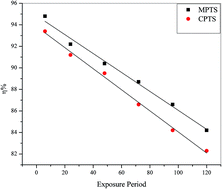Corrosion inhibition effect of spiropyrimidinethiones on mild steel in 15% HCl solution: insight from electrochemical and quantum studies
Abstract
The effect of synthesized spiropyrimidinethiones, namely, 6′-(4-methoxyphenyl)-1′-phenyl-2′-thioxo-2′,3′-dihydro-1′H-spiro[indoline-3,4′-pyrimidine]-2-one (MPTS) and 6′-(4-methoxyphenyl)-1′-phenyl-2′-thioxo-2′,3′-dihydro-1′H-spiro[indoline-3,4′-pyrimidine]-2-one (CPTS) on the corrosion of mild steel in 15% HCl solution was investigated by using weight loss and electrochemical methods. Both inhibitors act as mixed inhibitors and their adsorption on mild steel obeyed Langmuir's adsorption isotherm. The potential of zero charge (EPZC) for the mild steel was determined by electrochemical impedance spectroscopy methods. Scanning electron microscopy, energy dispersion X-ray spectroscopy, FTIR, X-ray photoelectron spectroscopy (XPS) and atomic force microscopy were used to characterize the surface morphology of the uninhibited and inhibited mild steel specimens. Density Functional Theory (DFT) was employed for theoretical calculations.


 Please wait while we load your content...
Please wait while we load your content...